Introduction
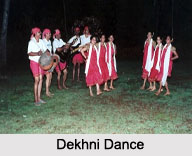 The folk dances of Goa bear a tradition of thousands of years, characterized by innumerable forms performed by and reflecting lifestyles, cultures and aspirations of different strata, religions and castes of Goan society. The prominent ones include the Dashavatara, Ghode Modni and the Goff Dance. Goa is also referred as the "Rome of East" is one of the most phenomenon and contemporary tourist destination in India with tradition Goan culture and folklore. Colonized by Portuguese for 450 years, cultural tradition of Goa consists of numerous Goa churches, temples and mosques.
The folk dances of Goa bear a tradition of thousands of years, characterized by innumerable forms performed by and reflecting lifestyles, cultures and aspirations of different strata, religions and castes of Goan society. The prominent ones include the Dashavatara, Ghode Modni and the Goff Dance. Goa is also referred as the "Rome of East" is one of the most phenomenon and contemporary tourist destination in India with tradition Goan culture and folklore. Colonized by Portuguese for 450 years, cultural tradition of Goa consists of numerous Goa churches, temples and mosques.
Soe of the popular folk dances of Goa are as follows:
The Dalo<
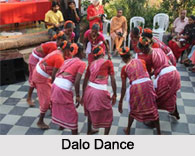 The Dalo is an earliest Goan folk dance completed mainly by women which combines dance, drama and music. Women dressed in multi-coloured traditional saris stand in two rows, facing each other and dance to the tune of musical folk songs. Previously the crop is cut and stored, the dalo is held at the village maand (sacred ground) on moonlit nights in winter (in the Hindu month of paush).
The Dalo is an earliest Goan folk dance completed mainly by women which combines dance, drama and music. Women dressed in multi-coloured traditional saris stand in two rows, facing each other and dance to the tune of musical folk songs. Previously the crop is cut and stored, the dalo is held at the village maand (sacred ground) on moonlit nights in winter (in the Hindu month of paush).
Diwli Nach
Diwli Nach is a dance performed in shigmo whilst balancing an oil-lamp with five light wicks on the head with no any support. The trick is not to lean or collapse the lamp during the dance. Though a great amount of attention is required to perform this job, the dancers go about it very naturally and elegantly.
Ghode Modni
It is a fighting dance performed in North Goa. The dance is held in shigmo by men flourishing swords and tiring a favourite subject who gives them the look of riding horses. The dance is said to portray the winning returning home of Rane"s warriors after defeating the opponent. The costumes are worn after carrying out spiritual rituals, typically in a temple.
Goff Dance
It is also performed during the shigmo celebration. In the village of Poiguinim, a group of men move from house to house performing this dance. Bright ropes are suspended from the roof of the matov (canopy). Each dancer holds one rope and to the rhythm of the song, performs the dance twining the ropes in the procedure to form a cord. Then they do reverse movements to untwine the ropes. In the village of Poiguinim, a group of men move from house to house performing this dance. Multi-coloured ropes are suspended from the roof of the matov (canopy). Each dancer holds one rope and to the beat of the song, performs the dance twining the ropes in the method to form a cord. Then they perform turn round movements to untwine the ropes.
Mando Folk Dance
Mando is a folk song where men and women replicate a mock flirtation to songs that speak expressively of desire and rejections of love. The mando is sung by the Christians in family celebrations like weddings and feasts. The western influenced melodies are played on a violin, while a ghumot (local percussion instrument) provides the hit.
Dhangar Dance<
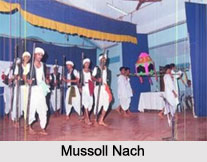 Dhangars from a community of shepherds who worship a folk god named as Bira Deva. They think in rituals and a variety of celebrations. They celebrate with dances on dhol and flute. The dances they carry out are frequently dedicated to Shri Radha and Krishna. The costumes they were are named as Kathiawari white dress.
Dhangars from a community of shepherds who worship a folk god named as Bira Deva. They think in rituals and a variety of celebrations. They celebrate with dances on dhol and flute. The dances they carry out are frequently dedicated to Shri Radha and Krishna. The costumes they were are named as Kathiawari white dress.
Morulem Dance
Morulem is a well-liked dance in which dancers dance on old and traditional songs to satisfy their deities. The costume of the dancers includes flower garlands as well as peacock feathers adorning the heads. This is a traditional folk dance presented by the backward community during Shigmo Festival.
Corredinho Dance
A Portuguese folk dance and a beautiful example of Portuguese cultural influence, this elegant dance is highly admired among Goan elite youth.
Fugdi Dance
Fugdi or "Foogdi" is the most popular folk dance form of Goa, performed only by women. Although mostly a non-religious, all-weather dance, it is danced on all-important social and spiritual occasions, and even at the end of other dances like Dalo. The dance starts with prayer to Hindu Gods at a slow pace of footwork in a circular formation, and rapidly it attains a fast pace reaching climax.
Kunbi Dance
Kunbis, the initial settlers of Goa, are a strong tribal community chiefly settled in Salcete Taluka, who though converted to Christianity, still retains the most ancient folk tradition of the ground. Their songs and dance belonging to the pre-Portuguese era are exclusively social and not spiritual. The fast and elegant dance by a group of Kunbi women dancers, wearing traditional yet very simple dresses, lends a colourful touch to this ethnic art form.
Talgadi Dance
In Talgadi, dancers move around the village and perform in house courtyards. They dance to the beats of instruments like Zanj, Shamel and Ghumat wearing colourful costumes and flowers.
Bhonvaddo Dance
This dance is a ritualistic dance which is typically held during the feast of the deity "Lairai" in Shirgao. The folk artists begin by encircling the temple. As they do so, the beat the "dhols", a drumming instrument.
Zagor Dance
"Zagor" is pure amusement. A tradition shared both by the Hindus and Catholics, is a relaxed mix of dance and theatre. Representation of everyday life, spoofs on present events and personalities, funny takes on characters such as the village eve teaser or the rude government official can be seen in "Zagor". This is mainly a folk Play. This is a cultural activity presented in different villages of Goa in different styles by the Gauda community.
Mussoll Nach
Mussoll Nach is a folk play-dance performed by the Kshatriyas among the Christians in Chandor village, Salcete taluka, on the second night of the Christian festival.
Tonyamel Folk Dance
This a type of folk dance that is performed with sticks. This is a very vigorous and muscular group dance, which is connected with the farm-folk celebrating the joys of good harvest. Tipri Nritya resembles tonyamel folk dance, which is very popular throughout the whole Goa. This is a folk dance performed by peasants working on farms to commemorate the festivities of good crop. The dance is performed in very energetic and hostile movements and with lots of noise and sound. The dance is a kind of respect paid to the Mother Nature and is quite charming.
Dekhni Dance
Dekhni is referred as a song cum dance. This is as the song has western bearings while the dance is of Indian form. It is only the women dancers who carry out this beautiful dance. A film producer got so enchanted by a popular Dekhni song that he made it well-known to every child of the country. Whenever this dance is performed, it is done with ghumat.
Bhandap Folk Dance
This is a traditional folk dance performed by the women folk of the scheduled tribe community who were the earliest settlers of Goa. That includes the second half of the Hindu month Bhadrapada.
Dhalo Danc e
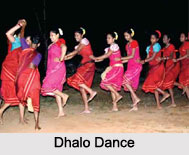 Dhalo is performed by women folk on the moonlit night of `Pausha` month. Compared to Fugdi dance, this dance is deliberate. The songs are in Konkani and Marathi. Normally 12- 24 women assemble after the dinner at a pre-selected specific spot in the square of a house in the village.
Dhalo is performed by women folk on the moonlit night of `Pausha` month. Compared to Fugdi dance, this dance is deliberate. The songs are in Konkani and Marathi. Normally 12- 24 women assemble after the dinner at a pre-selected specific spot in the square of a house in the village.
Romat Dance
This thanks-giving traditional dance-cum-parade performed in the Shigmo festival is known as Romat in the northern Goa and Mell in the central Goa. It is particularly crowded, loud and colourful matter.
Lamp Dance
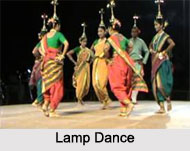 Women holding lamps on their heads perform this during Shigmo Festival. Thus this is only restricted to womenfolk.
Women holding lamps on their heads perform this during Shigmo Festival. Thus this is only restricted to womenfolk.
Mussal Dance
The Kshatriyas, the soldier class of `Chandor` carry out this dance-cum-song to rejoice the triumph of Harihar, the Hindu King of Vijaynagar over the Cholas in the early 14th century.
Veerbhadra Dance
It is a typical Indian style dance performed in Ponda, Sanguem and Bicholim Talukas.



















